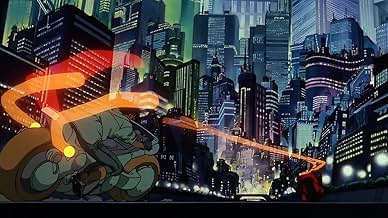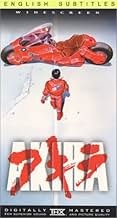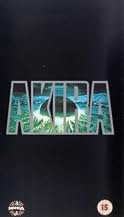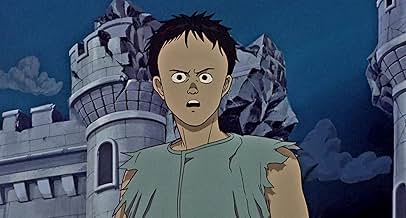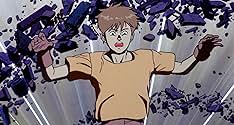Ein geheimes militärisches Projekt gefährdet Neo-Tokyo, als sich dadurch das Mitglied einer Motorradgang in einen randalierenden Psychopathen verwandelt, den nur zwei Teenager zusammen mit e... Alles lesenEin geheimes militärisches Projekt gefährdet Neo-Tokyo, als sich dadurch das Mitglied einer Motorradgang in einen randalierenden Psychopathen verwandelt, den nur zwei Teenager zusammen mit einer Gruppe von Menschen mit übernatürlichen Fähigkeiten aufhalten können.Ein geheimes militärisches Projekt gefährdet Neo-Tokyo, als sich dadurch das Mitglied einer Motorradgang in einen randalierenden Psychopathen verwandelt, den nur zwei Teenager zusammen mit einer Gruppe von Menschen mit übernatürlichen Fähigkeiten aufhalten können.
- Auszeichnungen
- 1 wins total
Mitsuo Iwata
- Shôtarô Kaneda
- (Synchronisation)
Nozomu Sasaki
- Tetsuo Shima
- (Synchronisation)
Mami Koyama
- Kei
- (Synchronisation)
Tesshô Genda
- Ryû
- (Synchronisation)
Hiroshi Ôtake
- Nezu
- (Synchronisation)
Kôichi Kitamura
- Lady Miyako
- (Synchronisation)
- …
Michihiro Ikemizu
- Inspector
- (Synchronisation)
- …
Yuriko Fuchizaki
- Kaori
- (Synchronisation)
Masaaki Ôkura
- Yamagata
- (Synchronisation)
Tarô Arakawa
- Eiichi Watanabe
- (Synchronisation)
- …
Takeshi Kusao
- Kai
- (Synchronisation)
Kazumi Tanaka
- Army
- (Synchronisation)
Masayuki Katô
- Engineer Sakiyama
- (Synchronisation)
- …
Yôsuke Akimoto
- Harukiya Bartender
- (Synchronisation)
Masato Hirano
- Yûji Takeyama
- (Synchronisation)
- …
Yukimasa Kishino
- Mitsuru Kuwata
- (Synchronisation)
- …
Kazuhiro Kandô
- Masaru (No. 27)
- (Synchronisation)
Tatsuhiko Nakamura
- Takashi (No. 26)
- (Synchronisation)
Empfohlene Bewertungen
I remember the first time i watched this when i was 14, back then it didn't mean much to me i just watched it because of the violence. Growing up i cant count the number of times i have watched it but it seems as though every time i watched it i uncovered something new in the plot. On to the review then; There are two different dubs for this film in English, the initial one i watched on VHS is much better then the one on DVD. The voices match the characters and bring across emotions very well in the VHS dub. In the DVD dub the voices seem alien to the characters personalities, this may be due to the fact that I'm used to seeing the film with the old dub.
The animation is very fluid, definitely a revolution in animation. The vast range of colours used really bring the metropolis alive. The start of the film where Kaneda and the crew are riding through the city you get to witness all sorts of sub-environments of the city, from tight alley ways where you can almost sense the deprivation to the bustling streets bright from the flashing neon lights.
The characters grow on you the further in to the film you get, at the beginning you can sense friction between Kaneda and Tetsuo, however as the film progresses you understand the past between these two characters and come to terms with their feelings. The colonel is also a very interesting character who seems to represent a beacon of hope constantly attempting to avoid the inevitable catastrophe headed for neo-tokyo.
The storyline revolves around two central characters, Tetsuo and Akira. It is heavily emphasised towards revealing what the next evolution of man is and whether or not the evolution would be in the best interest of man.
Closing comments, Akira is a must watch for any anime fan who appreciates a thought provoking storyline and dense characters.
Also watch; Ghost in the Shell, Ghost in the Shell:Innocence and Perfect Blue
The animation is very fluid, definitely a revolution in animation. The vast range of colours used really bring the metropolis alive. The start of the film where Kaneda and the crew are riding through the city you get to witness all sorts of sub-environments of the city, from tight alley ways where you can almost sense the deprivation to the bustling streets bright from the flashing neon lights.
The characters grow on you the further in to the film you get, at the beginning you can sense friction between Kaneda and Tetsuo, however as the film progresses you understand the past between these two characters and come to terms with their feelings. The colonel is also a very interesting character who seems to represent a beacon of hope constantly attempting to avoid the inevitable catastrophe headed for neo-tokyo.
The storyline revolves around two central characters, Tetsuo and Akira. It is heavily emphasised towards revealing what the next evolution of man is and whether or not the evolution would be in the best interest of man.
Closing comments, Akira is a must watch for any anime fan who appreciates a thought provoking storyline and dense characters.
Also watch; Ghost in the Shell, Ghost in the Shell:Innocence and Perfect Blue
When I first grabbed the cover box for AKIRA off the shelves of my local video store, I had never heard the word "manga," (Japanese comic book) nor "anime" (Japanimation) for that matter. Back then I would have given that movie a 9 (excellent), since it was like nothing I had ever seen before, was true graphic violence, but was still a bit too long and too hard to understand. Ten years later, having watched a slew of other anime productions, I would have given this movie an 8 (very good) from memory had I not seen it again yesterday. After seeing AKIRA for the first time in the original Japanese language, I have come to fully appreciate its cultural and artistic merit.
Ten years ago, I watched the English dubbed AKIRA and understood absolutely no Japanese. Ignorance of the language made for funny jokes with my brother ("Just as my bullet was reaching the red line! You think you're so tough") but added nothing to the movie. Ten years later I understand both the language and the country, thanks in part to AKIRA, and I have finally realized that Katsuhiro Otomo had created a classic. While critics may know the director Kurosawa, it may take another 10 years for the name Otomo to make its way to the forefront of American cinematic consciousness.
From here on out, I have nothing but praise for this historical milestone. No other hand-drawn movie I have ever seen is done as meticulously. The pillar lined coliseum comes to mind. It's apparent on first viewing that an immense amount of effort was put into the hand-drawn animation. It seems as if every detail within the frame is in motion. This stands out in the ANIME industry, where so many directors don't bother with effort and instead choose to have a still frame frozen over five seconds. In my mind AKIRA's animation is peerless on an international scale.
Second, the Neo Tokyo depicted in AKIRA is definitely the one that should exist today. Nightlife is dark and violent. Fundamentalist Buddhist sects roam the streets chanting dogma and searching for answers. And most importantly, the medicated punk teenagers speak a crooked, thuggish Japanese slang that I haven't heard in any movie of recent memory. 1988 was Japan's heyday, what with the bubble economy and all, but since then the artistic vision of Otomo's AKIRA seems to have gotten stuck in an economic recession. I feel as if modern Tokyo and its Anime has diverged quite a bit from the Neo-Tokyo depicted in AKIRA.
My final comment is DO NOT rent the English dubbed version, as I did long ago. If by chance you've developed a familiarity with Japan's language and culture, AKIRA makes so much more sense, as it was animated for the Japanese language. The poor English dub job does nothing but distract BIG TIME. As Japan's economically exuberant and excessive 80's heyday fades further into the past, AKIRA will prove to be a relic of a cult imagination that may be fading as well. To watch it in English would be sacrilegious.
In homage to this classic, I've titled my homepage AKIRA-TETSUO, which is named after that demonic anger and guilt you feel when you fail -- the emotion that you can harness to wreak atomic havoc upon this green planet earth. No happy ending with this cataclysmic movie.
JY
Jimboduck-dot-com
Ten years ago, I watched the English dubbed AKIRA and understood absolutely no Japanese. Ignorance of the language made for funny jokes with my brother ("Just as my bullet was reaching the red line! You think you're so tough") but added nothing to the movie. Ten years later I understand both the language and the country, thanks in part to AKIRA, and I have finally realized that Katsuhiro Otomo had created a classic. While critics may know the director Kurosawa, it may take another 10 years for the name Otomo to make its way to the forefront of American cinematic consciousness.
From here on out, I have nothing but praise for this historical milestone. No other hand-drawn movie I have ever seen is done as meticulously. The pillar lined coliseum comes to mind. It's apparent on first viewing that an immense amount of effort was put into the hand-drawn animation. It seems as if every detail within the frame is in motion. This stands out in the ANIME industry, where so many directors don't bother with effort and instead choose to have a still frame frozen over five seconds. In my mind AKIRA's animation is peerless on an international scale.
Second, the Neo Tokyo depicted in AKIRA is definitely the one that should exist today. Nightlife is dark and violent. Fundamentalist Buddhist sects roam the streets chanting dogma and searching for answers. And most importantly, the medicated punk teenagers speak a crooked, thuggish Japanese slang that I haven't heard in any movie of recent memory. 1988 was Japan's heyday, what with the bubble economy and all, but since then the artistic vision of Otomo's AKIRA seems to have gotten stuck in an economic recession. I feel as if modern Tokyo and its Anime has diverged quite a bit from the Neo-Tokyo depicted in AKIRA.
My final comment is DO NOT rent the English dubbed version, as I did long ago. If by chance you've developed a familiarity with Japan's language and culture, AKIRA makes so much more sense, as it was animated for the Japanese language. The poor English dub job does nothing but distract BIG TIME. As Japan's economically exuberant and excessive 80's heyday fades further into the past, AKIRA will prove to be a relic of a cult imagination that may be fading as well. To watch it in English would be sacrilegious.
In homage to this classic, I've titled my homepage AKIRA-TETSUO, which is named after that demonic anger and guilt you feel when you fail -- the emotion that you can harness to wreak atomic havoc upon this green planet earth. No happy ending with this cataclysmic movie.
JY
Jimboduck-dot-com
I only recently watched Akira (though I have heard a lot about it) and I must say I am impressed (so much that I bought the DVD). This is, beyond any doubt, one of the best animated films in existence. Visually impressive, solid direction, with a compelling story (if a little complicated), just the right amount of character development, good and very appropriate soundtrack and an extensively detailed New Tokyo, Akira manages to be as groundbreaking as it was when it was first released.
It's only drawback is that most people (including me) will probably have to watch it again (and again maybe) to completely understand the full story. Highly recommended (especially to anime fans). I give it 8 out of 10.
It's only drawback is that most people (including me) will probably have to watch it again (and again maybe) to completely understand the full story. Highly recommended (especially to anime fans). I give it 8 out of 10.
*Stereotype: Akira is a gratuitous bloodbath.
Maybe, but it's also a hard-nosed societal critique. Gore fans get what they want, but they have some morality shoved down their throats, as well. Most people who hate this movie watch it with a predetermined mindset. . . It takes thought and patience to piece together its sophisticated story.
*Stereotype: Akira rocks!!
The animation equals or exceeds Disney's best, the music is awesome, and the characters are complex, but "Akira" has its flaws. Chunked together from a long pre-existing storyline and filled with gritty violence, "Akira" draws fanatics too bloodthirsty to appreciate its message, and scares away critics intelligent enough to understand it. It takes a very open mind to enjoy this movie.
All in all, be careful with this movie; it's not for everyone. Just ignore the hype on BOTH sides and judge for yourself. I recommend the subtitled version; the dub's voice actors suck and anyone who'll understand this movie is obviously smart enough to read.
Maybe, but it's also a hard-nosed societal critique. Gore fans get what they want, but they have some morality shoved down their throats, as well. Most people who hate this movie watch it with a predetermined mindset. . . It takes thought and patience to piece together its sophisticated story.
*Stereotype: Akira rocks!!
The animation equals or exceeds Disney's best, the music is awesome, and the characters are complex, but "Akira" has its flaws. Chunked together from a long pre-existing storyline and filled with gritty violence, "Akira" draws fanatics too bloodthirsty to appreciate its message, and scares away critics intelligent enough to understand it. It takes a very open mind to enjoy this movie.
All in all, be careful with this movie; it's not for everyone. Just ignore the hype on BOTH sides and judge for yourself. I recommend the subtitled version; the dub's voice actors suck and anyone who'll understand this movie is obviously smart enough to read.
10toji
Without a doubt the necessary injection of Manga culture Western audiences needed. Personal objections (or should I say appraisals) aside, Akira deconstructs the form of narrative and character development that we had all become accustomed to through Hollywood and produces a reasonably honest translation of Katsuhiro Otomo's Manga epic, with mass deletions of unnecessary characters and plot avenues. The story is complex enough to keep western audiences attention, yet simple enough to digest whilst taking in the wonderfull animation and excellent soundtrack (a collection of traditional Japanese instruments and modern day synthesised electronica that allow for elements of cinema to establish themselves for the audience) The conflict between the two main characters, Tetsuo and Kaneda is ultimately superceded by the films namesake, the mystery of the boy Akira, and as with very few films Hollywood produces it leaves it's more labour intensive thinking until the end. A delight to follow, with periods of intense action and thought provoking predictions of a neo society, one would like to think of the film as the pipe dream of one who predicted such tragic events as of September 11. Akira, whilst violent for the medium, is a lush metropolis of gang warfare, a psuedo examination into the possible, and a fantasy tale of elements long lost in modern cinema. A cool, entertaining piece littered with cult visions and awesome bikes.
Wusstest du schon
- WissenswertesThe movie consists of 2,212 shots and 160,000 single pictures, 2-3 times more than usual, using 327 different colors (another record in animation film), 50 of which were exclusively created for the film. The reason for this statistic is that most of the movie takes place at night, a setting that is traditionally avoided by animators because of the increased color requirements.
- PatzerAfter the unnamed man escorting Takashi uses himself as a shield to protect him, Takashi apparently has spots of blood on his head, but as he gets up we see that blood was on the pavement and overlapped Takashi's head due to an animation error.
- Crazy CreditsThe date of the first coming of Akira is the exact same date as it was released originally in Japan.
- Alternative Versionen2001 re-release of the English language includes a new English dub script and voice cast.
- VerbindungenFeatured in Akira: Production Report (1988)
- SoundtracksTokyo Shoeshine Boy
Performed by Teruko Akatsuki
Top-Auswahl
Melde dich zum Bewerten an und greife auf die Watchlist für personalisierte Empfehlungen zu.
Details
Box Office
- Budget
- 1.100.000.000 ¥ (geschätzt)
- Bruttoertrag in den USA und Kanada
- 553.171 $
- Eröffnungswochenende in den USA und in Kanada
- 11.263 $
- 1. Jan. 1990
- Weltweiter Bruttoertrag
- 3.082.999 $
Zu dieser Seite beitragen
Bearbeitung vorschlagen oder fehlenden Inhalt hinzufügen




